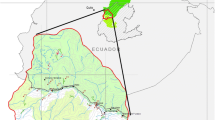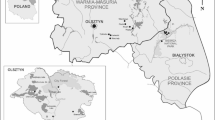Abstract
The diversity and the distribution of tick species and their infection rates by the pathogenic micro-organism Borrelia burgdorferi sensu lato, the etiologic agent of Lyme borreliosis, and Rickettsia sp., were studied in Canton Ticino (the southern part of Switzerland). Ticks specimens collected from animals and humans were classified and analysed for the presence of both pathogens. In particular, PCR analysis was performed for the detection of Borrelia spirochetes in Ixodes ricinus and Ixodes hexagonus, and the hemolymph test was done on Rhipicephalus sanguineus for the detection of Rickettsia sp. PCR assays, performed on 424 of the 989 collected ticks, revealed a low rate of infection (around 2%) of both vectors I. ricinus and I. hexagonus by B. burgdorferi sensu lato. These results are in agreement with the modest number of Lyme borreliosis cases yearly recorded in Ticino. Further, through analysis of DNA sequences, the strains carried by the infected ticks were identified as belonging to the genomic group VS116. The widespread finding of the Mediterranean species Rhipicephalus sanguineus in different locations from July 1994 to October 1995 demonstrates its establishment in Ticino. Of the 210 specimens collected, 70 were analysed and one was infected by Rickettsia sp.
Similar content being viewed by others
References
Barbour AG, Burgdorfer W, Hayes SF, et al. Isolation of a cultivable spirochete from Ixodes ricinus ticks of Switzerland. Curr Microbiol 8: 123–126.
Aeschlimann A, Burgdorfer W, Matile H, et al. Aspects nouveaux du rôle de vecteur joué par Ixodes ricinus L. en Suisse. Acta Tropica 1979; 36: 181–191.
Wilske B, Pfister HW. Lyme borreliosis research. Current Opinion in Infectious Diseases 1995; 8: 137–144.
Gilot B, Guiguen C, Degeilh B, et al. Phytoecological mapping of Ixodes ricinus as an approach to the distribution of Lyme borreliosis in France. In: Axford JS, Rees DHE (eds), Lyme borreliosis. New York: Plenum Press, 1994: 105–112.
Trevisan G, Simeoni J, Conci P, Bassot AM, Nobile C, Stinco G, Bianchi G, Rovetta G. Epidemiology of Lyme disease in Italy. In: Axford JS, Rees DHE (eds), Lyme borreliosis. New York: Plenum Press, 1994: 135–138.
Nuttall P, Randolph S, Carey D, Craine N, Livesley A, Gern L. The ecology of Lyme Borreliosis in the UK. In: Axford JS, Rees DHE (eds), Lyme borreliosis. New York: Plenum Press, 1994: 125–129.
Liebisch A, Olbrich S. The hedgehog tick, Ixodes hexagonus Leach, 1815, as a vector of Borrelia burgdorferi in Europe. In: Dusbabek F, Bukva V (eds). Prague: Modern Acarology Academia and The Huge: SPB Academic Publishing bv, 1991; 2: 67–71.
Curtin SM, Pennington TH. Borrelia burgdorferi studies in man and ticks in Scotland. In: Axford JS, Rees DHE (eds), Lyme borreliosis. New York: Plenum Press, 1994: 147–154.
Jaenson TGT, Bergström S, Mejlon HA, Noppa L, Olsén B, Tälleklint L. The ecology of Lyme borreliosis in Sweden. In: Axford JS, Rees DHE (eds), Lyme borreliosis. New York: Plenum Press, 1994; 113–115.
Steere AC. Lyme disease. N Engl J Med 1989; 321: 586–596.
Baranton G, Postic D, Saint Girons I, et al. Delineation of Borrelia burgdorferi sensu stricto, Borrelia garinii sp. nov., and group VS 461 associated with Lyme borreliosis. Int J Syst Bacteriol 1992; 42: 378–383.
Kawabata H, Masuzawa T, Yanagihara Y. Genomic analysis of Borrelia japonica sp. nov. isolated from Ixodes ovatus in Japan. Microbiol Immunol 1993; 37: 843–848.
Marconi RT, Liveris D, Schwartz I. Identification of novel insertion elements, restriction fragment length polymorphism patterns, and discontinuous 23S rRNA in Lyme disease spirochetes: phylogenetic analysis of rRNA genes and their intergenic spacers in Borrelia japonica sp. nov. and genomic group 21038 (Borrelia andersonii sp. nov.) isolates. J Clin Microbiol 1995; 33: 2427–2434.
Boerlin P, Péter O, Bretz AG, et al. Population genetic of Borrelia burgdorferi isolates by multilocus enzyme electrophoresis. Infect Imm 1992; 60: 1677–1683.
Balmelli T, Piffaretti JC. Analysis of the genetic polymorphism of Borrelia burgdorferi sensu lato with multilocus enzyme electrophoresis. Int J Syst Bacteriol 1996; 46(1): 167–172.
Valsangiacomo C, Balmelli T, Piffaretti JC. A phylogenetic study of Borrelia burgdorferi sensu lato based on sequence information from the hbb gene, coding for an histone-like protein. Int J Syst Bacteriol 1996 (in press).
Aeschlimann A, Büttiker W. Importations de tiques en Suisse (Acarina, Ixodoidea). Mitteilungen der Schweizerischen Entomologischen Gesellschaft 1975; 48(1–2).
Aeschlimann A, Schneeberger S, Pfister K, Burgdorfer W, Cotty A. Données nouvelles sur les tiques Ixodides du canton du Tessin (Suisse) et sur la présence d'agents rickettsiens dans leur hémolymphe. Annu Soc Helv Sci Nat 1986; 1: 58–68.
Péter O, Burgdorfer W, Aeschlimann A, Chatelanat P. Rickettsia conorii isolated from Rhipicephalus sanguineus introduced into Switzerland on a pet dog. Z Parasitenkd 1984; 70: 265–270.
Senevet G. Faune de France Ixodoidés (32). Fédération Française des Société Naturelles, Office Central de Faunistique. Paris 1937, Paul Lechevalier et fils, 100 pp.
Cotty A. Clef de détermination des Ixodidae et Amblyommidae de Suisse. Université de Neuchâtel, 1985, 119 pp.
He Q, Marjamaki M, Soini H, et al. Primers decisive for sensitivity of PCR. Biotechniques 1994; 17: 82–87.
Valsangiacomo C, Balmelli T, Piffaretti JC. A nested polymerase chain reaction for the detection of Borrelia burgdorferi sensu lato based on a multiple sequence analysis of the hbb gene. FEMS Microbiol Letters 1996; 136: 25–29.
Burgdorfer W. Hemolymph test. A technique for detection of rickettsiae in ticks. Amer J Trop Med Hyg 1970; 19: 1010–1014.
Giménez DF. Staining rickettsiae in yolk-sack cultures. Stain Technol 1964; 39: 135–140.
Misérez V, Gern L, Aeschlimann A. Borrelia burgdorferi in ticks of the canton of Tessin (Switzerland). Parassitologia (Rome) 1990; 32: 293–299
Toutoungi LN, Gern L, Aeschlimann A, Debrot S. A propos du genre Pholeoixodes, parasite des carnivores en Suisse. Acarologia 1991; 32(4): 311–328
Péter O, Bretz AG. Polymorphism of outer surface proteins of Borrelia burgdorferi as a tool for classification. Zbl Bakt 1992; 277: 28–33.
Postic D, Assous MV, Grimont PAD, Baranton G. Diversity of Borrelia burgdorferi sensu lato evidenced by restriction fragment length polymorphism of rrf (5S)-rrl (23S) intergenic amplicons. Int J Syst Bacteriol 1994; 44: 743–752.
Author information
Authors and Affiliations
Rights and permissions
About this article
Cite this article
Bernasconi, M.V., Valsangiacomo, C., Balmelli, T. et al. Tick zoonoses in the southern part of Switzerland (Canton Ticino): occurrence of Borrelia burgdorferi sensu lato and Rickettsia sp.. Eur J Epidemiol 13, 209–215 (1997). https://doi.org/10.1023/A:1007394901846
Issue Date:
DOI: https://doi.org/10.1023/A:1007394901846




